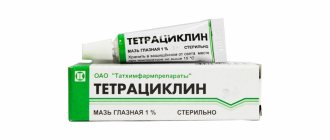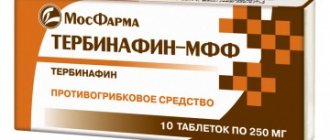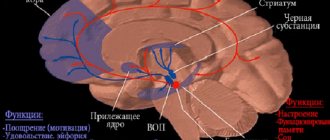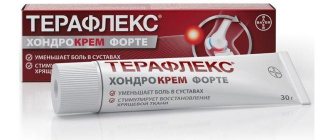Composition and release form
| Capsules | 1 caps. |
| chondroitin sulfate sodium | 0.25 g |
| excipients: lactose (milk sugar); calcium stearate | |
| gelatin capsule composition: titanium dioxide; Azorubine dye; crimson dye (Ponceau 4R); patented blue dye (patent blue V); diamond black dye (diamond black BN); methyl parahydroxybenzoate (methylhydroxybenzoate); propyl parahydroxybenzoate (propylhydroxybenzoate); acetic acid; gelatin |
in a blister pack 10 pcs.; in a cardboard pack of 5 packs or in jars of 20 pcs.; in a cardboard pack 1 jar.
| Ointment 5% | 100 g |
| chondroitin sulfate sodium (calculated on dry matter) | 5 g |
| dimexide (dimethyl sulfoxide) | 10 g |
| excipients (base): anhydrous lanolin; medical Vaseline; purified water |
in aluminum tubes of 30 g; in a cardboard pack 1 tube.
Overdose
The drug must be taken in strict accordance with the dosage prescribed in the medical institution. If you increase the prescribed dose yourself, this may cause an overdose. At the same time, a strong decrease in blood pressure is often accompanied by pulmonary embolism, myocardial infarction, and impaired blood flow in the brain.
Taking too much of the drug may cause an overdose
The condition requires immediate medical attention using symptomatic therapy and hemodialysis. Lack of timely assistance leads to the development of severe complications and death of the patient.
Pharmacodynamics
Capsules. Affects metabolic processes in hyaline and fibrous cartilage, reduces degenerative changes in the cartilage tissue of joints, stimulates the biosynthesis of glycosaminoglycans. Slows down bone resorption and reduces calcium loss, accelerates bone tissue restoration processes. When treated with Chondroitin-AKOS, pain decreases and mobility of the affected joints improves. The therapeutic effect persists for a long time after the end of the course of treatment.
Ointment. Chondroitin-AKOS contains chondroitin sulfate, a stimulator for the restoration of cartilage tissue in joints (chondroprotector), obtained from bovine tracheal cartilage, and dimethyl sulfoxide.
Chondroitin sulfate is a high-molecular mucopolysaccharide that inhibits the processes of destruction of cartilage tissue and accelerates the processes of its restoration. Suppresses enzymes that cause damage to cartilage tissue and prevents its degradation; stimulates the biosynthesis of glycosaminoglycans by chondrocytes; promotes the restoration of the joint capsule and cartilaginous surfaces of the joints, increases the production of intra-articular fluid. Improves phosphorus-calcium metabolism and reduces calcium loss in cartilage tissue, slows down bone resorption, normalizes metabolism in hyaline tissue, accelerates regeneration (recovery) processes and inhibits degeneration (destruction) of cartilage tissue. Structurally close to heparin, it prevents the formation of fibrin blood clots in the synovial and subchondral microvasculature. As a result of the effect, pain decreases and mobility of the affected joints increases.
Dimethyl sulfoxide, which is part of the ointment, has an anti-inflammatory, analgesic and fibrinolytic effect, promotes better penetration of chondroitin sulfate through cell membranes deep into tissues.
Chondroitin-AKOS ointment has an analgesic and anti-inflammatory effect, normalizes metabolism and stimulates restoration processes in joint tissues, leads to a reduction or disappearance of pain in the joints, improves joint mobility, and slows down the progression of osteoarthrosis and osteochondrosis.
Possible side effects
The abstract for Captopril indicates the possibility of developing the following negative consequences:
- numbness, tingling in the limbs;
- frequent headaches turning into migraines;
- fog, dizziness;
- chronic fatigue, muscle weakness;
- increased heart rate;
- disruption of the functioning of the digestive system (diarrhea or constipation, nausea, belching, heartburn, change in taste, loss of appetite, increased concentration of bilirubin, hepatitis, cholecystitis);
- changes in blood composition of a qualitative and quantitative nature;
- dysfunction of the urinary system.
Severe side effects include bronchospasms, Quincke's edema, swollen lymph nodes, and serum sickness.
Incorrect use of the medicine leads to side effects
Important! If such reactions occur, you should stop therapy and seek medical help.
Contraindications
For both dosage forms: hypersensitivity to the components of the drug.
For capsules additionally: children under 15 years of age (due to lack of accurate data).
With caution: bleeding and tendency to bleeding, thrombophlebitis.
For ointment additionally: acute inflammatory processes in the wound area; widespread tissue necrosis; excessive granulation; violation of the integrity of the skin at the sites of intended application.
With caution: do not use Chondroitin-AKOS ointment without consulting a doctor during pregnancy and breastfeeding, as well as in childhood.
Who is the drug prescribed to?
Indications for the use of Captopril Akos are quite limited. The drug is prescribed for the following conditions:
- hypertension due to impaired renal function;
- increased blood pressure, the etiology of which cannot be determined;
- hypertension of a malignant nature, when blood pressure cannot be normalized with medications;
- in complex therapy of left ventricular dysfunction, to prevent heart attack and other complications.
The drug is indicated for patients with arterial hypertension
The medicine is used both as an independent treatment and as an adjuvant therapy for conditions in patients characterized by increased blood pressure.
Directions for use and doses
Orally, during or after meals, with at least 1/2 glass of water.
Adults and adolescents over 15 years of age are prescribed 1 g/day (2 capsules 2 times a day).
The recommended duration of the initial course of treatment is 6 months, the period of action of the drug after its discontinuation is 3–5 months, depending on the location and stage of the disease, the duration of repeated courses of treatment is determined by the doctor.
Externally. Chondroitin-AKOS ointment is applied 2-3 times a day to the skin over the lesion and rubbed in for 2-3 minutes until completely absorbed. Typically, the course of treatment ranges from 2–3 weeks to 2 months. If necessary, the course of treatment is repeated.
Effect of the drug
Captopril Akos helps to reduce the rate of conversion of the hormone angiotensin I to angiotensin II, which ensures a decrease in blood pressure and the production of aldosterone by the adrenal cortex.
In this case, there is a decrease in the measure of tension in the wall of the left ventricle of the heart at the end of diastole, as well as the tension in the wall of the left ventricle during systole (pre- and afterload). The medicine reduces peripheral arterial resistance. In addition, the tablets lead to a decrease in the degradation of bradykinin and an increase in the formation of prostaglandin.
Plasma renin does not affect the effect of the drug. Normalization of blood pressure occurs even at medium and low concentrations of this substance.
Long-term therapy with the described drug can reduce myocardial hypertrophy and increase the heart's tolerance to physical activity.
Blood pressure decreases after taking the medication
The largest amount of the active component in the body is observed after 1–1.5 hours. The main actions of the product include:
- restoration of blood circulation in blood vessels;
- decreased bradykinin suppression;
- normalization of renal and coronary blood flow;
- drop in aldosterone production in the blood.
Important! To ensure the best results, it is recommended to take Captopril Akos only as prescribed by a doctor, strictly following the dosage and dosage regimen.
special instructions
If you miss taking a medication, the dose does not need to be increased; the next dose of medication is taken according to the prescribed regimen.
Despite the fact that the drug has positive reviews, it is highly not recommended to use it on your own.
It is prohibited to combine the product with alcoholic beverages.
During treatment, blood pressure should be measured regularly.
Patients undergoing therapy with the drug should undergo regular medical examinations and tests to monitor the vital systems of the body.
Patient reviews
Stepan, Samara “My sister is not yet 30, but she already suffers from periodic increases in blood pressure. She has a severe headache, tinnitus, and fatigue. I advised her on Captopril Akos, since I myself have been using this medicine for a long time, and it helps me well. The drug also worked for my sister, now the pills are always in her medicine cabinet, they have become a real first aid.”
Irina, Tomsk “Several years ago I was diagnosed with stage 2 hypertension, since then I have always had antihypertensive drugs at hand. I don’t use Captopril Akos every day; the doctor prescribed a milder medicine, but in case of a sharp and severe increase in blood pressure, this drug is simply necessary. I put the tablet under my tongue and after 20-30 minutes the condition improves. I think this remedy is an excellent way to prevent complications.”
Maxim, Kirov “Captopril Akos is really good at lowering blood pressure, but you need to know that you should not take more than 3 tablets per day, this can cause very serious consequences. One day my blood pressure increased significantly and I had to call an ambulance. It was Captopril Akos that knocked him down, and since then I always have this remedy with me.”
Stanislav, Moscow “I rarely use medications on my own, but recently I had to do it. While relaxing in nature, I suddenly felt sick, dizzy, had tinnitus, and increased blood pressure. My friends had Captopril tablets with them. Fortunately, they suited me well and my blood pressure dropped quickly, without any negative consequences for me. After that, I discussed the case with my doctor, and he advised me to keep the funds with me at all times.”
Azithromycin Forte-AKOS tablets p.p.o. 500mg N3
Action
Azithromycin is a broad-spectrum bacteriostatic antibiotic from the macrolide-azalide group.
Has a wide spectrum of antimicrobial action. The mechanism of action of azithromycin is associated with the suppression of protein synthesis in microbial cells. By binding to the 50S subunit of the ribosome, it inhibits peptide translocase at the translation stage, suppressing protein synthesis, slowing down the growth and reproduction of bacteria. In high concentrations it has a bactericidal effect. It is active against a number of gram-positive, gram-negative, anaerobic, intracellular and other microorganisms. 2 Microorganisms may be initially resistant to the action of an antibiotic or may acquire resistance to it. Pharmacokinetics
Azithromycin is rapidly absorbed from the gastrointestinal tract due to its stability in an acidic environment and lipophilicity. It is quickly distributed throughout the body, while high concentrations of the antibiotic are achieved in the tissues. After oral administration of 500 mg, the maximum concentration of azithromycin in the blood plasma is reached after 2.5–2.9 hours and is 0.4 mg/l. Bioavailability is 37.5%. Azithromycin penetrates well into the respiratory tract, organs and tissues of the urogenital tract (in particular, the prostate gland), skin and soft tissues. The high concentration in tissues (10–50 times higher than in plasma) and the long half-life are due to the low binding of azithromycin to plasma proteins, as well as its ability to penetrate eukaryotic cells and concentrate in the low pH environment surrounding lysosomes. This, in turn, determines the large apparent volume of distribution (31.1 l/kg) and high plasma clearance. The ability of azithromycin to accumulate predominantly in lysosomes is especially important for the elimination of intracellular pathogens. It has been proven that phagocytes deliver azithromycin to sites of infection, where it is released during the process of phagocytosis. The concentration of azithromycin in foci of infection is significantly higher than in healthy tissues (on average by 24–34%) and correlates with the degree of inflammatory edema. Azithromycin remains in bactericidal concentrations for 5–7 days after the last dose, which has made it possible to develop short (3-day and 5-day) courses of treatment. It is demethylated in the liver, the resulting metabolites are not active. The elimination of azithromycin from blood plasma occurs in 2 stages: the half-life is 14–20 hours in the interval from 8 to 24 hours after taking the drug and 41 hours in the range from 24 to 72 hours, which allows the drug to be used once a day. The drug is excreted mainly through the intestines unchanged - 50%, a small part is excreted by the kidneys - 6%.






